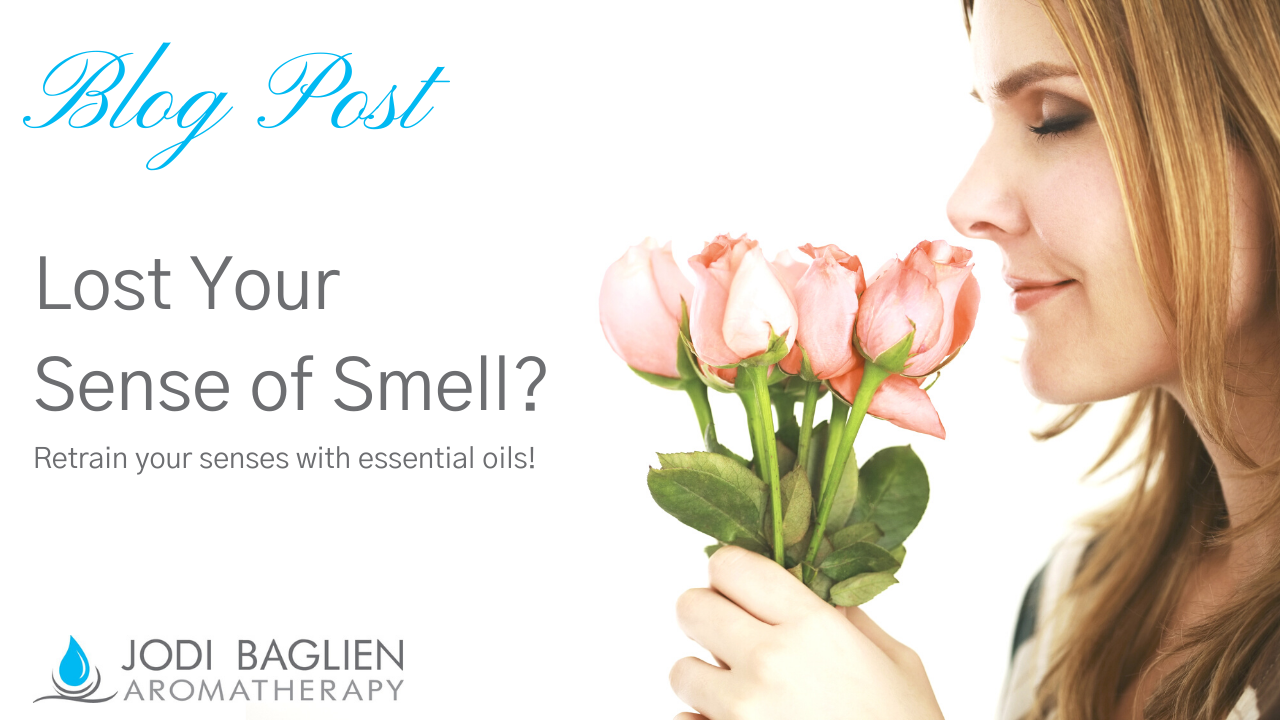Lost Your Sense of Smell? Retrain your Senses with Essential Oils!

Have You Experienced Loss of Smell Due to COVID-19? You Are Not Alone!
Loss of smell and taste is currently affecting around 50% of COVID-19 patients. For some people, this is the first symptom they notice before they get sick. Smell recovery typically occurs within a few months, but for others, it can take much longer for the olfactory system to recover normal smell and taste function. Read on to find out how essential oils can play a part of your recovery and help to retrain your olfactory system.
How Does COVID-19 Impact The Way We Smell?
It starts with our olfactory system. For more details about the olfactory system, read my blog, "How Do You Smell"!
COVID-19 can affect our olfactory system, two common side effects are:
- Anosmia - This the medical term for loss of smell and is commonly associated with traumatic brain injuries, aging, chronic upper respiratory infections, and now with COVID.
- Parosmia - Another olfactory condition affecting COVID 19 patients, where food and smells are highly distorted and horrible smelling.
Those suffering from parosmia report that food and other everyday smells have sudenly become horrible smelling, often using descriptors like rancid, burnt, has a chemical smell, or putrid. Parosmia can present early in the progression and recovery of the virus, or for some, it occurs months later, even after they have recovered their sense of smell and taste. The duration of parosmia can be weeks to months and some believe it to be part of the process of the olfactory sensory nerves regenerating after this illness.
Parosmia makes exposure to everyday cooking smells or being in any type of “scented” environment very difficult and frustrating. Exposure to others preparing or sharing meals becomes a source of anxiety, alienation and frustration. This detrimentally affects their quality of life, their health and mental health.
Retraining the Olfactory System is Possible
The use of essential oils alone to regain your sense of smell has merit, but best practice has been when the oils are used as a part of an overall medically directed treatment plan. Recent research shows that smelling a series of 4 essential oils, for 3-6 months daily, when used along with your Physicians treatment plans including prescribed medication, were helpful 44% of the time.
How it Works
The essential oils aspect of the olfactory retraining protocol is quite simple. It consists of using 4 essential oils of different odor families. Working with your physician to rule out other nasal conditions is important, and the best results in the studies resulted when the oils were used in combination with prescribed medications.
The following protocal is derived from a variety of public information and research, see below for sources.
Olfactory Training Technique Consists of:
- Smell each of the 4 oils used in the study, twice a day, every day for 3-6 months, or until smell recovers.
- The oils used are Lemon, Eucalyptus, Clove and Rose.
- Inhale each oil slowly & deeply, thru each nostril, while trying to remember what the oil smells like, for about 30 seconds. This may helps re-establish the smell receptors, and regain smell memory.
- Pause for 10-15 seconds, and then repeat the process for the other 3 oils.
Studies suggest switching to a new set of 4 oils, after 3 months to ignite new receptors and neural connections. For some people, the first 4 oils were helpful by themselves.

Resources
For more information about olfactory retraining, anosmia, parosmia, I highly recommend you visit Absent.Org a site rich with information for the public. You can also search for support groups on Facebook where Covid-19 sufferers are sharing their experience with smell loss and recovery and find community support.
Research
“The American Laryngological, Rhinological and Otological Society” August of 2019 there is an article called “Effectiveness of Olfactory Training on Different Severities of Posttraumatic Loss of Smell” which outlines and presents this research, its findings, and is quite informative
Effectiveness of Olfactory Training on Different Severities of Post traumatic Loss of Smell. Robert Pellegrino, MS; Pengfei Han, PhD; Nicole Reither, MD; Thomas Hummer, MD August 2019
Source – The Laryngoscope Copyright 2019 The American Laryngological, Rhinological and Otological Society, Inc
The evidence for olfactory training in treating patients with olfactory loss.
Zara M. Patel. Copyright 2017 Wolters Kluwer Health, Inc.
Irrigation with olfactory training improves outcomes – International Forum of Allergy & Rhinology, Vol 8, No 9, September 2018 American Rhinologic Society (ARS)
Stay connected with us for updates, success stories, and Aromatherapy musings!
Be a part of the culture shift - receive information about Aromatherapy in healthcare.
Don't worry, we don't send too much and your information will not be shared.
50% Complete
Two Step
Lorem ipsum dolor sit amet, consectetur adipiscing elit, sed do eiusmod tempor incididunt ut labore et dolore magna aliqua.

